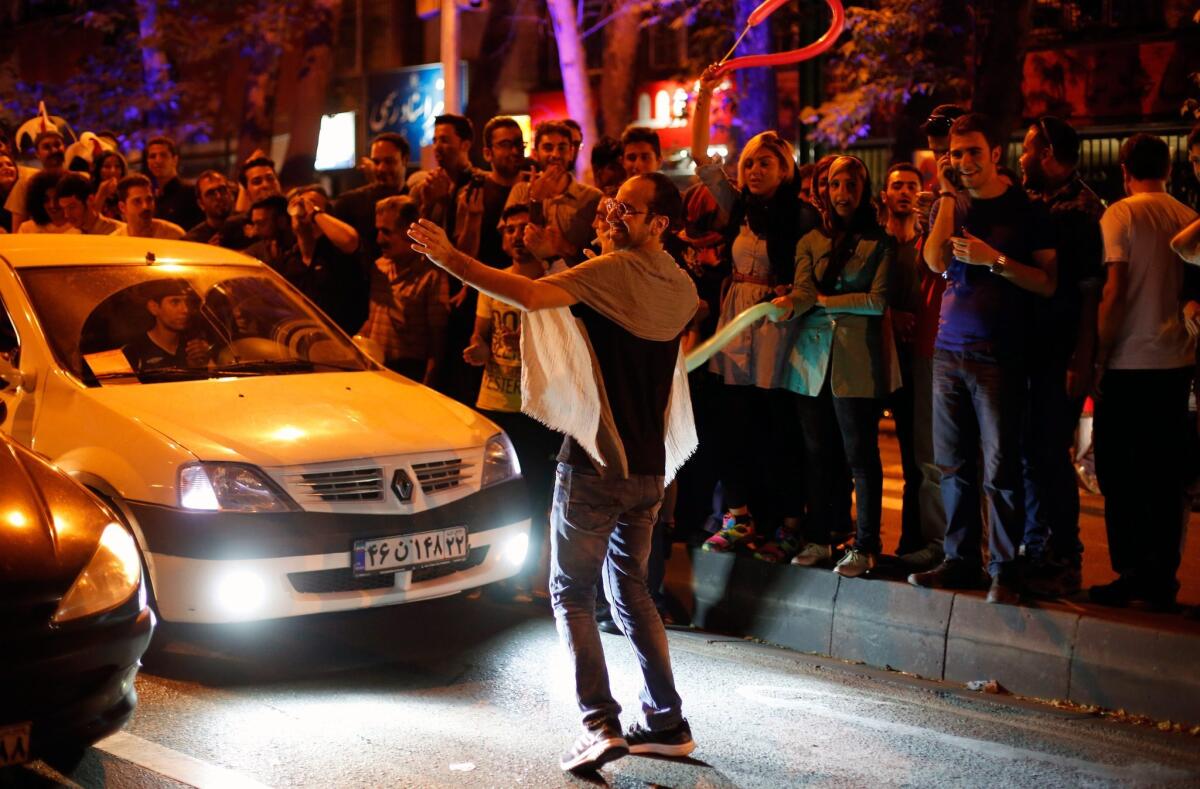Column: Don’t like the Iran deal? What’s the alternative?

Iranians celebrate in the streets of Tehran on July 14, after nuclear talks between Iran and World powers ended in Vienna, Austria.
- Share via
The nuclear agreement the U.S. and its allies concluded with Iran on Tuesday isn’t perfect; diplomatic compromises rarely are. The deal allows Iran to continue enriching uranium within limits, but the limits begin to phase out after 10 years. It lifts the international arms embargo on Iran after five years. And it relies heavily on inspections by the International Atomic Energy Agency to make sure Iran doesn’t cheat.
All of those provisions are worrisome, and not only to the mostly Republican critics who lined up to denounce the 159-page deal before they had time to read it. There are skeptics in both parties, and many of their concerns are legitimate.
------------
FOR THE RECORD
Iran deal: In Doyle McManus’ July 15 column, he misidentified Sen. Tom Cotton’s home state. Cotton represents Arkansas, not Oklahoma.
------------
But President Obama and his aides are relying on a three-word question to protect the agreement from congressional interference: “Compared to what?”
“That’s the killer argument,” one of the U.S. participants in the negotiations told me.
They’re right. Anyone who proposes rejecting this nuclear deal should be required to lay out an alternative course, and to show clearly that the alternative is both feasible and better.
The deal’s opponents haven’t really done that — because there are no easy alternatives. They called on Obama to halt the talks, but they never quite spelled out what he should do on Day Two. Now that Obama has concluded a deal, they want Congress to block it — but they rarely talk about the real-world consequences.
“I think we should have walked away from the table a long time ago and pressed the pause button to get back to that original goal of stopping Iran from developing any nuclear weapons capabilities,” Sen. Tom Cotton (R-Okla.) said this week. And just how would we achieve that goal? Beyond imposing more U.S. economic sanctions on Iran, Cotton and his colleagues haven’t gotten very specific.
Here’s the main problem, one many American politicians hate to acknowledge: The sanctions that prodded Iran’s supreme leader, Ayatollah Ali Khamenei, into a deal were imposed by a huge international coalition — one that included Russia, China and India as well as traditional U.S. allies. If the U.S. walks away from an agreement its allies have enthusiastically embraced, that coalition will almost certainly collapse.
“Sanctions are only effective if we are able to bring the world with us,” an Obama aide said Tuesday. “A vote to kill this deal could potentially be a vote to kill the sanctions regime.”
Yes, Congress could maintain or even escalate U.S. sanctions — but Iran could shrug them off and sell its oil to China, India and other buyers. Sanctions imposed by only one country rarely work; they certainly can’t cripple an economy that has oil to sell.
A second potential consequence of walking away from the table was outlined by Obama on Tuesday morning. “Without this deal, there would be no agreed-upon limitations for the Iranian nuclear program,” he said. “Iran could produce, operate and test more and more centrifuges.... And we would not have any of the inspections that allow us to detect a covert nuclear weapons program.”
That doesn’t mean Iran would sprint toward a nuclear weapon; most Iran-watchers think Tehran would probably be cautious, if only to avoid provoking new sanctions.
But without inspections, fear of Iran’s nuclear capabilities would inevitably grow in Israel and the United States — and eventually lead to renewed pressure for military action against Tehran. In 2010, the last time nuclear negotiations hit a dead end, Israeli officials openly discussed the possibility of launching airstrikes to prevent Iran from building a bomb.
“Put simply, no deal means a greater chance of more war in the Middle East,” Obama said.
Or, in Secretary of State John F. Kerry’s phrasing: “What’s the alternative? Go to war now?”
In the next 60 days, the period Congress has given itself to review the agreement, scrutiny will rightly focus on the deal’s weak points:
Does it really lengthen Iran’s “breakout time” — the time it needs to assemble a nuclear weapon — to a year? (Administration officials say the deal would actually do better than the one-year target.)
Can the inspection and verification rules work? (Officials insist that the answer is yes. “We have unbelievable, really extraordinary and unprecedented transparency measures to understand what’s happening in Iran’s program,” one of the U.S. negotiators said.)
And, most important, does the “snapback” mechanism amount to a real insurance policy? (If Iran were to violate the deal, the other participants could take the issue to the U.N. Security Council; if the council didn’t act, sanctions would be automatically reimposed.)
Let’s say the agreement is full of loopholes. In that case, critics will be able to argue that it’s a bad deal, the kind Obama once said he’d reject. But even then, the core question will remain: Compared to what? Unless the deal’s opponents can provide a convincing answer, they’re going to have a hard time building a veto-proof majority to block the deal when Congress votes on it this fall.
Twitter: @DoyleMcManus
Follow the Opinion section on Twitter @latimesopinion and Facebook
More to Read
A cure for the common opinion
Get thought-provoking perspectives with our weekly newsletter.
You may occasionally receive promotional content from the Los Angeles Times.











